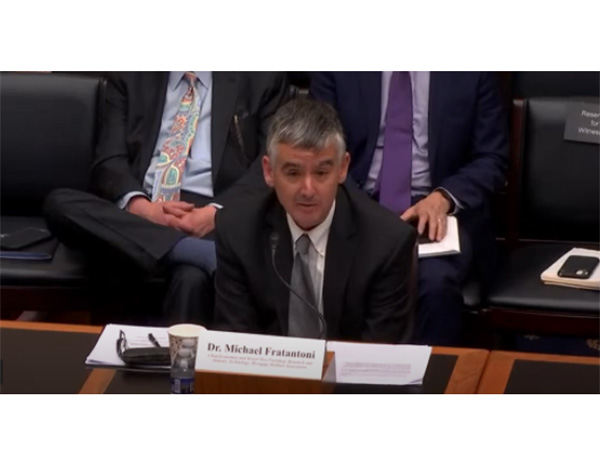
Statement of MBA’s Michael Fratantoni Before the House Financial Services Subcommittee on Housing and Insurance

(Mike Fratantoni testifies; Image via GOPFinancialServices/Youtube)
Mike Fratantoni, MBA’s Chief Economist and SVP of Research and Industry Technology, testified yesterday at a hearing titled, “The Characteristics and Challenges of Today’s Homebuyers” before the Committee on Financial Services Subcommittee on Housing and Insurance.
Hearing details can be found here. Click here for Fratantoni’s written statement.
[Note: Please find Mr. Fratantoni’s prepared oral statement below. Fratantoni may add to or subtract from these remarks during the course of his testimony.]
ORAL STATEMENT
MBA Chief Economist and SVP of Research and Industry Technology Mike Fratantoni
3/20/2024
Chairman Davidson, Ranking Member Cleaver, and members of the subcommittee, thank you for the opportunity to testify today. My name is Mike Fratantoni – and I am MBA’s Chief Economist and Senior Vice President of Research and Industry Technology.
My testimony today reviews current trends in the mortgage market – focusing on the buyers, products, sources of financing, and obstacles that homebuyers and lenders face.
In my written statement, I also examine some of the current trends in the rental housing market – including that for single-family rentals.
How large is the single-family residential mortgage market? $45 trillion in real estate is owned by households – with $32 trillion in home equity – and $13 trillion in mortgage debt outstanding.
In 2021, lenders originated a record amount – almost $4.5 trillion in mortgages. To contrast that, MBA is forecasting about $2.0 trillion in originations for 2024 – up from $1.6 trillion in 2023.
These mortgages fund both the purchase of homes and the refinancing of existing loans – supporting a U.S. homeownership rate that in recent years has hovered around 65%.
Regrettably, there remains a wide homeownership gap across different racial and ethnic groups.
—
Of the $13 trillion of mortgage debt outstanding, roughly $9 trillion is securitized through Ginnie Mae and the housing Government Sponsored Enterprises – Fannie Mae and Freddie Mac. Most of the remaining $4 trillion of mortgage debt is held on bank portfolios as whole loans – with some held by other types of investors.
Before the Great Financial Crisis, as much as half of securitized mortgage volume was private label. The PLS sector is much smaller in today’s market, comprising $80 billion or so of the $1.6 trillion originations in 2023. About $30 billion of this volume in 2023 was non-Qualified Mortgages – known as non-QM – with more flexible underwriting standards intended for self-employed borrowers or others with more complex financial or employment patterns.
Typically, more than 80% of mortgages used to purchase a home are 30-year fixed-rate mortgages – while many refinance borrowers opt for shorter-term, 10-, 15-, or 20-year mortgages. Most of the remaining loans, which are a small percentage of overall volume, are hybrid adjustable-rate mortgages, with initial fixed-rate periods of 5, 7, or 10 years – and then more frequent rate adjustments.
2022 HMDA data show us that 70% of homebuyers who used mortgage financing took out conventional conforming loans securitized through the GSEs. 14% used FHA loans – 9% VA Home Loans – 1% RHS loans – and 6% used conventional jumbo loans.
MBA’s mortgage applications data typically show that about 90% of applications are for buyers who intend to occupy their properties as primary residences – while the remaining 10% are for second homes or investor properties.
Roughly half of all “purchase mortgages” are for first-time home buyers, who rely mainly on government housing programs for their loans. In particular, the FHA supported affordable mortgage financing for more than 478,000 first-time homebuyers in Fiscal Year 2023, representing more than 82% of its forward mortgage business.
Of course, not all homebuyers utilize mortgage financing, some purchase properties with cash. For existing homes, roughly 28% of buyers purchased with cash in 2023. For new homes, more than 8% were cash buyers.
—
Lenders with different business models tend to focus on distinct types of lending. For example, independent mortgage banks – or IMBs – tend to focus primarily on their growing share of government and conventional loans to first-time homebuyers and low-and moderate-income buyers – while depositories have concentrated more on ARMs and jumbo loans for their retail banking clients that they hold on their portfolios.
MBA’s members believe the biggest single challenge in today’s housing market is the lack of adequate inventory. Housing supply is millions of units short of that needed to support the corresponding demographic demand.
Given the lack of housing supply and brisk demand, home prices increased 39% over the 2020-2022 timeframe. Mortgage rates reached record lows below 3% during the pandemic. In 2022, to combat inflation, the Federal Reserve briskly raised short-term rates and 30-year mortgage rates more than doubled in response.
The net impact of the higher rates and home prices was a dramatic reduction in affordability.
—
My written statement outlines certain regulatory challenges facing the mortgage market – including the Basel III “Endgame” proposal’s likely impact on mortgage credit – as well as the current cost – and the lack of availability – of homeowner’s insurance. MBA appreciates the focus on these two issues by the members of this subcommittee.
—
Thank you again for the opportunity to walk through these latest market trends with you.
I look forward to your questions.
